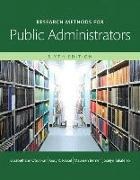Read more
Informationen zum Autor Elizabethann O'Sullivan , Professor Emeritus in the Department of Political Science and Public Administration at the University of North Carolina at Charlotte, passed away in 2014. Gary Rassel is Professor Emeritus in the Department of Political Science and Public Administration at the University of North Carolina at Charlotte. Maureen Berner is Professor of Public Administration and Government in the School of Government at the University of North Carolina at Chapel Hill. Jocelyn DeVance Taliaferro is Associate Professor in the Department of Social Work at North Carolina State University. Zusammenfassung Research Methods for Public Administrators introduces students to the methodological tools public administrators and policy analysts use to conduct research in the twenty-first century. Full of engaging examples and step-by-step instructions to illustrate common research methods and techniques, this book provides future administrators with an unshakeable foundation in model building, research design, and statistical applications. New to the Sixth Edition: Sections addressing recent developments in research methods, such as Big Data and Exploratory Data Analysis Expanded coverage of digital media, including internet surveys and survey data collection by tablet computers Greater focus on qualitative research methods and their strengths and weaknesses relative to quantitative methods Updated study items, knowledge questions, homework exercises, and problem assignments for each chapter Inhaltsverzeichnis Contents Preface to the Sixth Edition Acknowledgements Chapter 1: Beginning a Research Project Starting a Research Project Using Models to Organize the Research Study Building the Model Types of Models Limitations of Models and Model Building for Specific Users The Components of Models Selecting a Research Question Notes Terms for Review Questions for Review Problems for Homework and Discussion Recommended for Further Reading Chapter 2: Design for Description Research Methodology Types of Studies Designs to Find Relationships and Show Trends Meta-Analysis Qualitative Research and Designs to Fill in the Details Focus Groups Notes Terms for Review Problems for Homework and Discussion Recommended for Further Reading Chapter 3: Designs for Explanation Establishing Causal Relationships Internal and External Validity Experimental Designs Quasi-Experimental Designs Nonexperimental Designs Determining Causality with Cross-Sectional Studies Notes Terms for Review Questions for Review Problems for Homework and Discussion Working With Data Recommended for Further Reading Chapter 4: Measuring Variables Beginning the Measurement Process Measurement and Measurement Scales Reliability Operational Validity Sensitivity Summary Notes Terms for Review Questions for Review Problems for Homework and Discussion Working with Data Recommended for Further Reading Chapter 5: Sampling Probability Sampling Designs Nonprobability Sampling Designs Sample Size Notes Terms for Review Questions for Review Problems for Homework and Discussion Working with Data Recommended for Further Reading Chapter 6: Contacting and Talking to Subjects Survey Research Contacting Subjects Planning for a Survey Mailed Questionnaires Internet Surveys Telephone Surveys In-Person Interviewing ...

